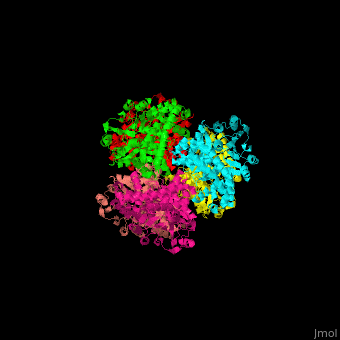Function
Glutamate dehydrogenase (GLDH) catalyzes the reversible conversion of glutamate to α-ketoglutarate (AKG) and ammonium. The ammonia is removed via the urea cycle. NAD or NADP is a cofactor in GLDH activity. NAD is a cofactor in the forward reaction while NADP is a cofactor in the reverse reaction. GLDH is regulated by the cell’s energy state. ATP and GTP inhibit the enzyme while ADP, GDP and leucine positively enhance it[1]. Glutamate dehydrogenase 1 (GLDH1) catalyzes the deamination of glutamate to 2-oxoglutarate and ammonium. GLDH1 is regulated in the same manner as GLDH[2].
See also Citric Acid Cycle.
Relevance
Elevated GLDH values in blood serum indicate liver malfunction[3].
Disease
Mutations in GLDH1 are associated with familial hyperinsulinism[4].
Structural highlights
The biological assembly of GLDH from Clostridium symbiosum is . The is in a cleft between the two domains of the enzyme with [5]. Water molecules are shown as red spheres.
3D structures of glutamate dehydrogenase
Glutamate dehydrogenase 3D structures

